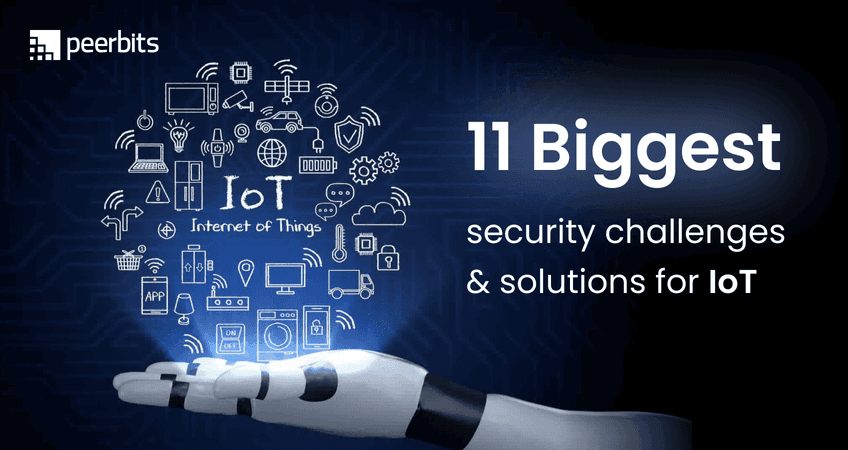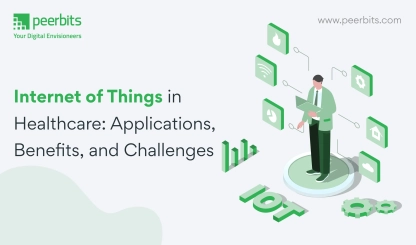The Internet of Things (IoT) is revolutionizing the way we live and work. It enables us to connect and control a wide range of devices, from smartphones and laptops to home appliances and industrial equipment, using a single network.

However, as the number of connected devices increases, so do the security challenges associated with them. In this blog, we will discuss the 11 biggest security challenges and the solutions for IoT that can help address them.
Security Challenge 1: Lack of standardization
One of the biggest security challenges in IoT is the lack of standardization. With so many different devices, protocols, and platforms, it is difficult to ensure compatibility and interoperability between them. This can lead to vulnerabilities that can be exploited by attackers.
Solutions
-
Developing and adopting industry standards for IoT devices, protocols, and platforms can help ensure compatibility and interoperability. This can include standards for device security, data privacy, and communication protocols.
-
Certifying IoT devices and platforms can help ensure that they meet certain security standards. This can give organizations more confidence in the security of the devices they are using, and can also help identify devices that may be more susceptible to attack.
-
Using a secure gateway can help ensure that all devices on the network are communicating securely. For example, a secure gateway can be used to encrypt communications, authenticate devices, and monitor network traffic for suspicious activity. This can help reduce the risk of attacks and increase the overall security of the network.
Security Challenge 2: Weak or non-existent authentication
Another major challenge facing IoT is weak or non-existent authentication. Many IoT devices are designed with minimal security, making them vulnerable to attacks.
Solutions
-
Implementing strong authentication methods, such as two-factor authentication, can help ensure that only authorized users have access to the device.
-
Using a secure gateway can help ensure that all devices on the network are communicating securely.
-
Using Public Key Infrastructure (PKI) can help ensure that all devices on the network are authentic.
Security Challenge 3: Inadequate software security
IoT devices often run on embedded systems with limited resources, making it difficult to secure them. This can lead to vulnerabilities that can be exploited by attackers. Additionally, embedded systems often have specialized hardware and software, which can create additional challenges when it comes to securing them.
Solutions
-
Implementing secure IoT app development practices, such as threat modeling and code reviews, can help ensure that software is secure. By incorporating these practices into the development process, organizations can help to reduce the risk of attacks and increase the security of their IoT devices.
-
Using secure boot and secure firmware update processes can help ensure that the device is running trusted software. Secure firmware update processes can ensure that the device is running the latest version of the firmware, and that any updates are authentic and have not been tampered with.
-
Using a secure gateway can help ensure that all devices on the network are communicating securely. A secure gateway acts as a central point of control for all devices on the network, and it can help ensure that all devices are communicating securely. This can help reduce the risk of attacks and increase the overall security of the network.
Security Challenge 4: Insufficient network security
IoT devices often connect to the internet using unsecured networks, making them vulnerable to attacks. For example, an attacker could intercept communications between an IoT device and the internet, potentially gaining access to sensitive data.
Additionally, unsecured networks can also be used to launch attacks on other devices on the network.
Solutions
-
Implementing secure network protocols, such as VPN and HTTPS, can help ensure that data is transmitted securely. Virtual Private Networks (VPNs) can be used to encrypt communications between IoT devices and the internet, making it more difficult for attackers to intercept data.
HTTPS, on the other hand, can be used to encrypt communications between web servers and clients, providing an additional layer of security for web-enabled IoT devices. -
Using a secure gateway can help ensure that all devices on the network are communicating securely. For example, a secure gateway can be used to encrypt communications, authenticate devices, and monitor network traffic for suspicious activity. This can help reduce the risk of attacks and increase the overall IoT security of the network.
-
Implementing network segmentation can help limit the impact of an attack on the network. Network segmentation involves dividing a network into smaller sub-networks, or segments, to limit the scope of an attack. For example, an organization could segment their network so that all IoT devices are on a separate segment from the rest of the network.
-
This can help to limit the impact of an attack on IoT devices, as the attacker would only be able to access the segment containing the IoT devices, rather than the entire network.
Security Challenge 5: Limited physical security
Limited physical security is a significant challenge facing IoT devices as they are often small and easy to conceal, making them vulnerable to physical attacks. A physical attack on an IoT device can include tampering, theft, or destruction of the device. This can result in unauthorized access to sensitive information, system downtime, and loss of data.
Solutions
-
Implementing physical security measures, such as locks and cameras, can help ensure that devices are protected against physical attacks. This can include using tamper-proof enclosures, security locks, and surveillance cameras to monitor the location of the devices.
-
Using tamper-evident packaging can also help ensure that devices have not been tampered with before they reach their final destination. This can include using special packaging materials that are designed to show signs of tampering, such as seals that will break if the packaging is opened.
-
Regularly reviewing the physical security of devices and updating the software to the latest version can also help ensure that devices are protected against physical attacks. This includes conducting regular physical security audits, monitoring the device's location, and ensuring that all devices are updated with the latest security patches.

Security Challenge 6: Inadequate data protection
Inadequate data protection is a significant security challenge facing IoT devices as they generate and collect a large amount of data, making it vulnerable to attacks. This data can include personal information, financial information, and other sensitive information.
If this data is not properly protected, it can fall into the wrong hands and be used for malicious purposes.
Solutions
-
Implementing data encryption can help ensure that it is protected against attacks and that only authorized users have access to it. This can include using secure encryption algorithms, such as AES or RSA, to encrypt data at rest and in transit.
-
Regularly reviewing the security of devices and updating the software to the latest version can also help ensure that data is protected. This includes conducting regular security audits, monitoring the device's location, and ensuring that all devices are updated with the latest security patches.
-
Implementing access controls can also help ensure that only authorized users have access to the data. This can include using role-based access controls, multi-factor authentication, and other security measures to ensure that only authorized users can access the data.
Security Challenge 7: Limited privacy protections
IoT devices often collect and transmit personal data, making it important to protect users' privacy. This can include data such as personal information, location data, and other sensitive information. If this data is not properly protected, it can be used for targeted advertising, identity theft, or other malicious purposes.
Solutions
-
Implementing privacy-enhancing technologies, such as anonymization and pseudonomization. Anonymization is the process of removing personal identifiers from data, making it impossible to identify individuals.
Pseudonomization is the process of replacing personal identifiers with pseudonyms, making it difficult to identify individuals. These technologies can help protect users' personal data and ensure that it is not used for malicious purposes. -
Having clear and transparent privacy policies in place can also help inform users about how their data is being collected, stored, and used. This can include providing information about what data is being collected, how it is being used, and who it is being shared with. It also includes giving users the ability to opt-out or delete their data.
-
Regularly reviewing the security of devices and updating the software to the latest version can also help ensure that any privacy vulnerabilities are addressed. This includes conducting regular security audits, monitoring the device's location, and ensuring that all devices are updated with the latest security patches.
Security Challenge 8: Inability to update or patch devices
Many IoT devices are difficult or impossible to update or patch, making them vulnerable to attacks. This means that once a vulnerability is discovered, it cannot be fixed, making the device vulnerable to attacks.
Furthermore, some devices are no longer supported by their manufacturers, making it impossible to receive any security updates or patches. This lack of updateability and patchability makes it difficult to protect these devices from known vulnerabilities and exploits, leaving them open to cyberattacks.
Solutions
-
Using a secure gateway is another important step in ensuring the security of IoT devices. A secure gateway acts as a central point of control for all devices on the network, and can be used to monitor and control the communication between devices, ensuring that it is secure.
This can include encryption and authentication to prevent unauthorized access to the network. -
Regularly reviewing the security of devices and updating the software to the latest version is also important for protecting IoT devices against attacks. This helps ensure that devices are running the most recent version of the software, which may include security patches and updates.
It is also important to check the security settings of devices, and change them if they are not configured properly.
Security Challenge 9: Limited regulatory oversight
The limited regulatory oversight of IoT (Internet of Things) devices can be a major security concern, as it makes it difficult to ensure that these devices are secure. To address this issue, several solutions have been proposed, including:
Solutions
-
Developing and enforcing regulations for IoT devices: Governments and other regulatory bodies can develop and enforce regulations for IoT devices, which can help ensure that these devices are designed and manufactured to meet certain security standards. This can include requirements for encryption, authentication, and other security measures.
-
Certifying IoT devices and platforms: Certifying IoT devices and platforms can also help ensure that they meet certain security standards. This can include certifications for specific security features, such as encryption and authentication, as well as certifications for compliance with specific security standards, such as ISO 27001.
-
Having a security incident response plan in place: Having a security incident response plan in place can help ensure that any security incidents are quickly and effectively addressed. This can include procedures for identifying and responding to security breaches, as well as procedures for reporting security incidents to the appropriate authorities.
Security Challenge 10: Lack of visibility and control
IoT devices are designed to operate in the background, often without the user's knowledge or interaction. This can make it difficult to understand their behavior and control their actions.
For example, an IoT device such as a smart camera may be sending data to a cloud service without the user's knowledge. This lack of visibility into the device's behavior can make it difficult to detect and prevent malicious activity.
Solutions
-
Developing tools to monitor and control IoT devices can help ensure that they are operating as intended by providing visibility into their behavior. This can include monitoring network traffic, identifying and blocking suspicious activity, and tracking device activity over time.
Additionally, these tools can be used to control the actions of IoT devices, such as disabling specific features or shutting down devices that are behaving unexpectedly. -
Regularly reviewing the security of devices and updating the software to the latest version is another important step in ensuring the security of IoT devices. This can include identifying vulnerabilities in the device's software and hardware, and applying patches or updates to fix these vulnerabilities.
-
Additionally, regularly updating the software can ensure that devices are running the latest security features and are able to respond to new security threats.
-
Implementing network segmentation can help limit the impact of an attack on the network by isolating IoT devices from the rest of the network. This can include creating separate networks for IoT devices and other devices, such as laptops and smartphones, and limiting the communication between these different networks.
Additionally, network segmentation can be used to control the flow of traffic between different parts of the network, making it more difficult for an attacker to move laterally through the network.
Security Challenge 11: Difficulty in detecting and responding to threats
IoT devices, such as smart thermostats, security cameras, and smart appliances, often operate in the background, constantly collecting and transmitting data. Because these devices are connected to the internet and often have minimal user interaction, it can be difficult to detect and respond to security threats.
For example, a hacker may be able to gain access to a device without the user's knowledge and use it to launch a cyber attack.
Solutions
-
Implement security monitoring and incident response processes. This can include regular monitoring of device activity, as well as implementing tools and techniques to detect unusual or suspicious behavior.
For example, security software can be installed on the device to monitor network traffic and alert administrators to any potential threats. -
Another solution is to have a security incident response plan in place. This plan should outline the steps to be taken in the event of a security incident, including who is responsible for responding, what actions should be taken, and how to communicate the incident to relevant parties.
This can help ensure that any security incidents are quickly and effectively addressed. -
It is also important to regularly review the security of devices and update the software to the latest version. Software updates often include security patches and bug fixes, which can help address known vulnerabilities and prevent potential attacks. Additionally, it is important to ensure that devices are configured properly, with strong passwords and limited access to the device.
-
Regularly reviewing the security of devices and updating the software to the latest version.
Conclusion
In conclusion, the Internet of Things (IoT) has brought about many benefits, but it has also introduced a host of security challenges. These security challenges for IoT include device vulnerabilities, data privacy concerns, and network insecurity.
To address these challenges, you can consult an IoT app development company who will implement robust security measures such as device authentication, encryption, and regular software updates.
Additionally, IoT devices should be designed with security in mind from the outset, and companies should have a clear and transparent data privacy policy in place. By addressing these security challenges head-on, an IoT app development company with its reliable iot app development services can ensure the safety and security of their devices and the data they collect and transmit.









